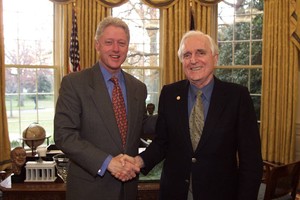Doug Engelbart’s Design for High Performance Innovative Organizations
Change Your Organization’s Nervous System
I have been a fan and follower of Doug Engelbart since I first discovered his work in the early 1970s. After his death in 2013, I revisited a videotaped interview I did with Doug in November of 1991, entitled, Together We Will Get There. Its goal was to have Doug describe much of his seminal thinking about how to design high performance organizations. This is a classic interview and is well worth watching in its entirety. In this article, I summarize a few of the high points from that interview.
NETTING IT OUT
When Douglas C. Engelbart died on July 2, 2013, at the age of 88, lots of people contributed their recollections and appreciation for the myriad contributions Doug made to computing and collaborative work. He was dubbed the father of the Mouse, the inventor of Windows, and many other things. I remember Doug as a loving father figure who held a big vision most of his career about how groups of people could work together more productively and more collaboratively using computing and networking in ways that most of us hadn’t even dreamed of. But Doug not only dreamed; he also designed and built software and hardware systems collaboratively with a team of co-creators and explorers. They envisioned, built, and used collaborative knowledge tools to augment human intelligence.
Douglas C. Engelbart
(January 30, 1925 - July 2, 2013)
There are four aspects of his legacy I found myself thinking about after Doug’s passing:
1. Why it’s necessary to change our organizations’ nervous systems
2. How knowledge work is actually done within and across organizations
3. The information architecture that’s required to support people working together and discovering and learning from one another
4. How organizations (and the people within them) actually learn and evolve
While lots of Doug’s and his teams’ inventions have already transformed the ways in which we work and communicate and interact with one another in the Internet age, there are still major portions of Doug’s legacy that we still need to bring into being.
Doug Engelbart with President Clinton in the Oval Room on the occasion of receiving the National Medal of Technology on Dec. 1, 2000
Photo: The White House
DOUG’S VISION: CHANGE YOUR ORGANIZATION’S NERVOUS SYSTEM
Why It’s Necessary to Change Our Organizations’ Nervous Systems
Doug Engelbart liked to compare organizations to living organisms; both evolve in response to the world around them. He said that, like living, biological creatures, organizations mutate, and those mutations are continually being tested for survival value within their environment.
Today’s Organizations Are in Danger of Extinction
Engelbart felt that:
“Today’s environment is beginning to threaten today’s organizations—finding them seriously deficient in their nervous system design—and that the degree of coordination, perception, rational adaptation, etc., which will appear in the next generation of human organizations will drive our present organizational forms, with their clumsy nervous systems, into extinction.”1
~ Doug Engelbart, 1970
You Can’t Deal with the Complexity of Today’s World Unless You Change the Nervous System of Your Organization
Doug said that as organizations develop the kind of new nervous system that will be possible by adopting an information and communications infrastructure that lets people develop, integrate, and apply knowledge concurrently and openly, those organizations will begin to evolve naturally into much more effective high-performance organizations. And he asserted that there would be an order of magnitude difference between an organization that has learned how to harness this new nervous system and evolutionary capability and the organizations that don’t learn.
Designing a Better Organizational Nervous System
Since the late 1950s, Doug Engelbart worked throughout his career (until a few years before his death in July, 2013) on the redesign of organizational nervous systems. Doug foresaw that the nervous systems that organizations had evolved in order to thrive in the industrial age were not going to be adequate to take them into the knowledge age.
“I’ve had this image of organizations that are really superlatively more effective. It’s hard to communicate that vision. So one analogy I like to make is: Consider an organic organism, a biological one. It’s growing. And suppose that in a very, very short period of time, evolutionary-wise, a brand new nervous system comes up that is much faster and has much more central capacity, much better sensors, and all of that, and you think, ‘is that organism just going to harness that so that it can work a little faster and see farther?’ No, the whole organism is going to start evolving to harness all that better. And that’s what organizations are going to do.”
~ Doug Engelbart in his interview with Patty Seybold, 1991
My Interview with Doug Engelbart on November 15, 1991
Start by Augmenting Humans’ Capacity to Develop, Integrate, and Apply Knowledge
Doug felt that what was needed was a major advance in organizations’ abilities to sense, to observe, to think, and to assimilate, apply, and refine knowledge. Organizations are composed of humans, so it’s appropriate, Doug reasoned, to begin by looking...
(Download the PDF to read the entire article.)
Contact Info:
Christina Engelbart
christina@dougengelbart.org
or:
The Doug Engelbart Institute
333 Ravenswood Avenue, AE-111,
Menlo Park, CA 94025
Info@dougengelbart.org
Phone: 650.859.4664
Other Articles We’ve Published about Doug Engelbart’s Work:
- Toward Boosting Our Collective IQ: A Knowledge-Centric Approach; A Selection of Writings by Douglas C. Engelbart, By Doug Engelbart and Christina Engelbart, March 10, 2011
- Improve Your Ecosystem’s Ability to Tackle Complex Issues, by Patricia Seybold, June 6, 2010 [Outside Innovation blog]
- Bootstrapping Innovation; Leveraging the Collective IQ to Achieve Powerful Results, by Ronni Marshak, June 3, 2010
- A Commitment to Complete the Work of Augmenting Human Intelligence, by Patricia Seybold, December 11, 2008 [Outside Innovation blog]
- Doug Engelbart’s Design for Knowledge-Based Organizations-Part 1, by Patricia Seybold, February 12, 1992 [Paradigm Shift; ISSN: 1054-3929]
- Doug Engelbart’s Design for Knowledge-Based Organizations-Part 2, by Patricia Seybold, March 25, 1992 [Paradigm Shift; ISSN: 1054-3239]
- Together We Can Get There! Video of Interview of Douglas C. Engelbart by Patricia Seybold, November 15, 1991
- Tymshare’s Augment; Heralding a New Era, October 1978, [The Seybold Report on Word Processing; ISSN: 0160-9572] (out of print)
Sign in to download the full article
1 comment
-
 umar khan on April 12, 2023 at 6:31 a.m.Thank you for helping people get the information they need. Great stuff as usual. Keep up the great work!!! The Continuum Showflat
umar khan on April 12, 2023 at 6:31 a.m.Thank you for helping people get the information they need. Great stuff as usual. Keep up the great work!!! The Continuum Showflat





